Physical and Mechanical Properties of a Bulk Lightweight Concrete with Expanded Polystyrene (EPS) Beads and Soft Marine Clay
Abstract
:1. Introduction
2. Materials and Methods
2.1. Materials
2.2. Experimental Procedure
2.2.1. Mixing Ratios and Preparation of Specimen
2.2.2. Test Method
3. Results and Discussions
3.1. Mass Density
3.2. Stress–Strain Behaviors
3.3. Compressive Strength Versus Failure Strain
3.4. Compressive Strength Versus Mass Density
3.5. Compressive Strength Versus Curing Time
4. Conclusions
Author Contributions
Funding
Acknowledgments
Conflicts of Interest
References
- Teerawattanasuk, C.; Voottipruex, P.; Horpibulsuk, S. Mix design charts for lightweight cellular cemented Bangkok clay. Appl. Clay Sci. 2015, 104, 318–323. [Google Scholar] [CrossRef]
- Jamsawang, P.; Poorahong, H.; Yoobanpot, N.; Songpiriyakij, S.; Jongpradist, P. Improvement of soft clay with cement and bagasse ash waste. Constr. Build. Mater. 2017, 154, 61–71. [Google Scholar] [CrossRef]
- Emmanuel, E.; Lau, C.; Anggraini, V.; Pasbakhsh, P. Stabilization of a soft marine clay using halloysite nanotubes: A multi-scale approach. Appl. Clay Sci. 2019, 173, 65–78. [Google Scholar] [CrossRef]
- Saisubramanian, R.; Murugaiyan, V.; Sundararajan, T. Studies on characteristics, applications and strength improvement of marine clay: a review. J. Geosci. Environ. Prot. 2019, 7, 93–106. [Google Scholar] [CrossRef]
- Tsuchida, T.; Tang, Y. Estimation of compressive strength of cement-treated marine clays with different initial water contents. Soils Found. 2015, 55, 359–374. [Google Scholar] [CrossRef] [Green Version]
- Kang, G.; Tsuchida, T.; Kim, Y. Strength and stiffness of cement-treated marine dredged clay at various curing stages. Constr. Build. Mater. 2017, 132, 71–84. [Google Scholar] [CrossRef]
- Liu, Y.; Hu, J.; Li, Y.; Li, L. Statistical evaluation of the overall strength of a soil-cement column under axial compression. Constr. Build. Mater. 2017, 132, 51–60. [Google Scholar] [CrossRef]
- Yoobanpot, N.; Jamsawang, P.; Horpibulsuk, S. Strength behavior and microstructural characteristics of soft clay stabilized with cement kiln dust and fly ash residue. Appl. Clay Sci. 2017, 141, 146–156. [Google Scholar] [CrossRef]
- Cheng, Q.; Kai, Y.; Yong, L. Stress-dependent behavior of marine clay admixed with fly-ash-blended cement. Int. J. Pavement Res. Technol. 2018, 11, 611–616. [Google Scholar] [CrossRef]
- Jongpradist, P.; Jamsawang, P.; Kongkitkul, M. Equivalent void ratio controlling the mechanical properties of cementitious material-clay mixtures with high water content. Mar. Georesour. Geotechnol. 2019. [Google Scholar] [CrossRef]
- Wang, D.; Xiao, J.; Gao, X. Strength gain and microstructure of carbonated reactive MgO-fly ash solidified sludge from East Lake, China. Eng. Geol. 2019, 251, 37–47. [Google Scholar] [CrossRef]
- Horpibulsuk, S.; Phojan, W.; Suddeepong, A.; Chinkulkijniwat, A.; Liu, M. Strength development in blended cement admixed saline clay. Appl. Clay Sci. 2012, 55, 44–52. [Google Scholar] [CrossRef] [Green Version]
- Horpibulsuk, S.; Rachan, R.; Suddeepong, A.; Liu, M.; Du, Y. Compressibility of lightweight cemented clays. Eng. Geol. 2013, 159, 59–66. [Google Scholar] [CrossRef]
- Meguid, M.A.; Hussein, M.G. A numerical procedure for the assessment of contact pressures on buried structures overlain by EPS geofoam inclusion. Int. J. Geosynth. Gr. Eng. 2017, 3, 2. [Google Scholar] [CrossRef]
- Wang, D.; Wang, H.; Wang, X. Compressibility and strength behavior of marine soils solidified with MgO—A green and low carbon binder. Mar. Georesour. Geotechnol. 2017, 35, 878–886. [Google Scholar] [CrossRef]
- Wang, D.; Zentar, R.; Abriak, N. Temperature-accelerated strength development in stabilized marine soils as road construction materials. J. Mater. Civ. Eng. 2017, 29, 04016281. [Google Scholar]
- Al-Naddaf, M.; Han, J.; Xu, C.; Rahmaninezhad, S. Effect of geofoam on vertical stress distribution on buried structures subjected to static and cyclic footing loads. J. Pipeline Syst. Eng. Pract. 2019, 10, 04018027. [Google Scholar] [CrossRef]
- Horpibulsuk, S.; Suddeepong, A.; Chinkulkijniwat, A.; Liu, M. Strength and compressibility of lightweight cemented clays. Appl. Clay Sci. 2012, 69, 11–21. [Google Scholar] [CrossRef] [Green Version]
- Liu, N.; Chen, B. Experimental study of the influence of EPS particle size on the mechanical properties of EPS lightweight concrete. Constr. Build. Mater. 2014, 68, 227–232. [Google Scholar] [CrossRef]
- Allahvedi, A.; Azimi, S.A.; Alibabaie, M. Development of multi-strength grade green lightweight reactive powder concrete using expanded polystyrene beads. Constr. Build. Mater. 2018, 172, 457–467. [Google Scholar] [CrossRef]
- Lee, J.H.; Kang, S.H.; Ha, Y.J.; Hong, S.G. Structural behavior of durable composite sandwich panels with high performance expanded polystyrene concrete. Int. J. Concr. Struct. Mater. 2018, 12, 21. [Google Scholar] [CrossRef]
- Wang, J.; Sun, W.; Anand, S. Numerical investigation on active isolation of ground shock by soft porous layers. J Sound Vib. 2009, 321, 492–509. [Google Scholar] [CrossRef]
- Bathurst, R.J.; Zarnani, S. Earthquake load attenuation using EPS geofoam buffers in rigid wall applications. Indian Geotech. J. 2003, 43, 283–291. [Google Scholar] [CrossRef]
- Ertugrul, O.L.; Trandafir, A.C.; Ozkan, Y. Reduction of dynamic earth loads on flexible cantilever retaining walls by deformable geofoam panels. Soil Dyn. Earthq. Eng. 2017, 92, 462–471. [Google Scholar] [CrossRef]
- Gao, H.; Hu, Y.; Wang, Z.; Wang, C.; Chen, G. Shaking table tests on the seismic performance of a flexible wall retaining EPS composite soil. Bull. Earthq. Eng. 2017, 15, 5481–5510. [Google Scholar] [CrossRef]
- Kaya, A.; Kar, F. Properties of concrete containing waste expanded polystyrene and natural resin. Constr. Build. Mater. 2016, 105, 572–578. [Google Scholar] [CrossRef]
- Fernando, P.; Jayasinghe, M.; Jayasinghe, C. Structural feasibility of expanded polystyrene (EPS) based lightweight concrete sandwich wall panels. Constr. Build. Mater. 2017, 139, 45–51. [Google Scholar] [CrossRef]
- Ferrándiz-Mas, V.; García-Alcocel, E. Durability of expanded polystyrene mortars. Constr. Build. Mater. 2013, 46, 175–182. [Google Scholar] [CrossRef] [Green Version]
- Wu, Y.; Wang, J.; Paulo, J.M.M.; Zhang, M.H. Development of ultra-lightweight cement composites with low thermal conductivity and high specific strength for energy efficient buildings. Constr. Build. Mater. 2015, 87, 100–112. [Google Scholar] [CrossRef]
- Li, C.; Miao, L.; You, Q.; Hu, S.; Fang, H. Effects of viscosity modifying admixture (VMA) on workability and compressive strength of structural EPS concrete. Constr. Build. Mater. 2018, 175, 342–350. [Google Scholar] [CrossRef]
- Fan, R.; Du, Y.; Reddy, K.; Liu, S.; Yang, Y. Compressibility and hydraulic conductivity of clayey soil mixed with calcium bentonite for slurry wall backfill: Initial assessment. Appl. Clay Sci. 2014, 101, 119–127. [Google Scholar] [CrossRef]
- Fan, R.; Liu, M.; Du, Y.; Horpibulsuk, S. Estimating the compression behaviour of metal-rich clays via a disturbed state concept (DSC) model. Appl. Clay Sci. 2016, 132, 50–58. [Google Scholar] [CrossRef]
- Neramitkornburi, A.; Horpibulsuk, S.; Shen, S.; Arulrajah, A.; Disfani, M. Engineering properties of lightweight cellular cemented clay-fly ash material. Soils Found. 2015, 55, 471–483. [Google Scholar] [CrossRef]
- Fathi, M.; Yousefipour, A.; Farokhy, E. Mechanical and physical properties of expanded polystyrene structural concretes containing Micro-silica and Nano-silica. Constr. Build. Mater. 2017, 136, 590–597. [Google Scholar] [CrossRef]
- Giorgio, I.; Scerrato, D. Multi-scale concrete model with rate-dependent internal friction. Eur. J. Environ. Civ. Eng. 2017, 21, 821–839. [Google Scholar] [CrossRef]
- Por, S.; Nishimura, S.; Likitlersuang, S. Deformation characteristics and stress responses of cement-treated expansive clay under confined one-dimensional swelling. Appl. Clay Sci. 2017, 146, 316–324. [Google Scholar] [CrossRef]
- Hu, X.; Zhang, Y.; Guo, L.; Wang, J.; Cai, Y.; Fu, H.; Cai, Y. Cyclic behavior of saturated soft clay under stress path with bidirectional shear stresses. Soil Dyn. Earthq. Eng. 2018, 104, 319–328. [Google Scholar] [CrossRef]
- Placidi, L.; Barchiesi, E.; Misra, A. A strain gradient variational approach to damage: A comparison with damage gradient models and numerical results. Math. Mech. Complex Syst. 2018, 6, 77–100. [Google Scholar] [CrossRef]
- Sadrmomtazi, A.; Sobhani, J.; Mirgozar, M.A.; Najimi, M. Properties of multi-strength grade EPS concrete containing silica fume and rice husk ash. Constr. Build. Mater. 2012, 35, 211–219. [Google Scholar] [CrossRef]
- Ram Rathan Lal, B.; Nawkhare, S. Experimental study on plastic strips and EPS beads reinforced bottom ash based material. Int. J. Geosynth. Gr. Eng. 2016, 2. [Google Scholar] [CrossRef]
- Cai, G.; Liu, S. Compaction and mechanical characteristics and stabilization mechanism of carbonated reactive MgO-stabilized silt. KSCE J. Civ. Eng. 2017, 21, 2641–2654. [Google Scholar] [CrossRef]
- Fantilli, A.P.; Chiaia, B. Mechanical performances of mortar prisms and concrete slabs incorporating rubber aggregates. Mech. Res. Commun. 2018, 92, 118–123. [Google Scholar] [CrossRef]
- Deng, X.; Klein, B.; Tong, L.; de Wit, B. Experimental study on the rheological behavior of ultra-fine cemented backfill. Constr. Build. Mater. 2018, 158, 985–994. [Google Scholar] [CrossRef]
- Jamsawang, P.; Suansomjeen, T.; Sukontasukkul, P.; Jongpradist, P.; Bergado, D. Comparative flexural performance of compacted cement-fiber-sand. Geotext. Geomembr. 2018, 46, 414–425. [Google Scholar] [CrossRef]
- Yoonz, G.; Jeon, S.; Kim, B. Mechanical characteristics of light-weighted soils using dredged materials. Mar. Georesour. Geotechnol. 2004, 22, 215–229. [Google Scholar] [CrossRef]
- Liu, H.L.; Deng, A.; Chu, J. Effect of different mixing ratios of polystyrene pre-puff beads and cement on the mechanical behaviour of lightweight fill. Geotext. Geomembr. 2006, 24, 331–338. [Google Scholar] [CrossRef]
- Chung, S.Y.; Abd Elrahman, M.; Stephan, D. Effects of Expanded Polystyrene (EPS) Sizes and Arrangements on the properties of Lightweight Concrete. Mater. Struct. 2018, 51, 57. [Google Scholar] [CrossRef]
- Kamruzzaman, A.; Chew, S.; Lee, F. Structuration and destructuration behavior of cement-treated singapore marine clay. J. Geotechnol. Geoenviron. 2009, 135, 573–589. [Google Scholar] [CrossRef]
- Du, H.; Pang, S. Value-added utilization of marine clay as cement replacement for sustainable concrete production. J. Clean. Prod. 2018, 198, 867–873. [Google Scholar] [CrossRef]
- Du, Y.; Wei, M.; Jin, F.; Liu, Z. Stress–strain relation and strength characteristics of cement treated zinc-contaminated clay. Eng. Geol. 2013, 167, 20–26. [Google Scholar] [CrossRef]
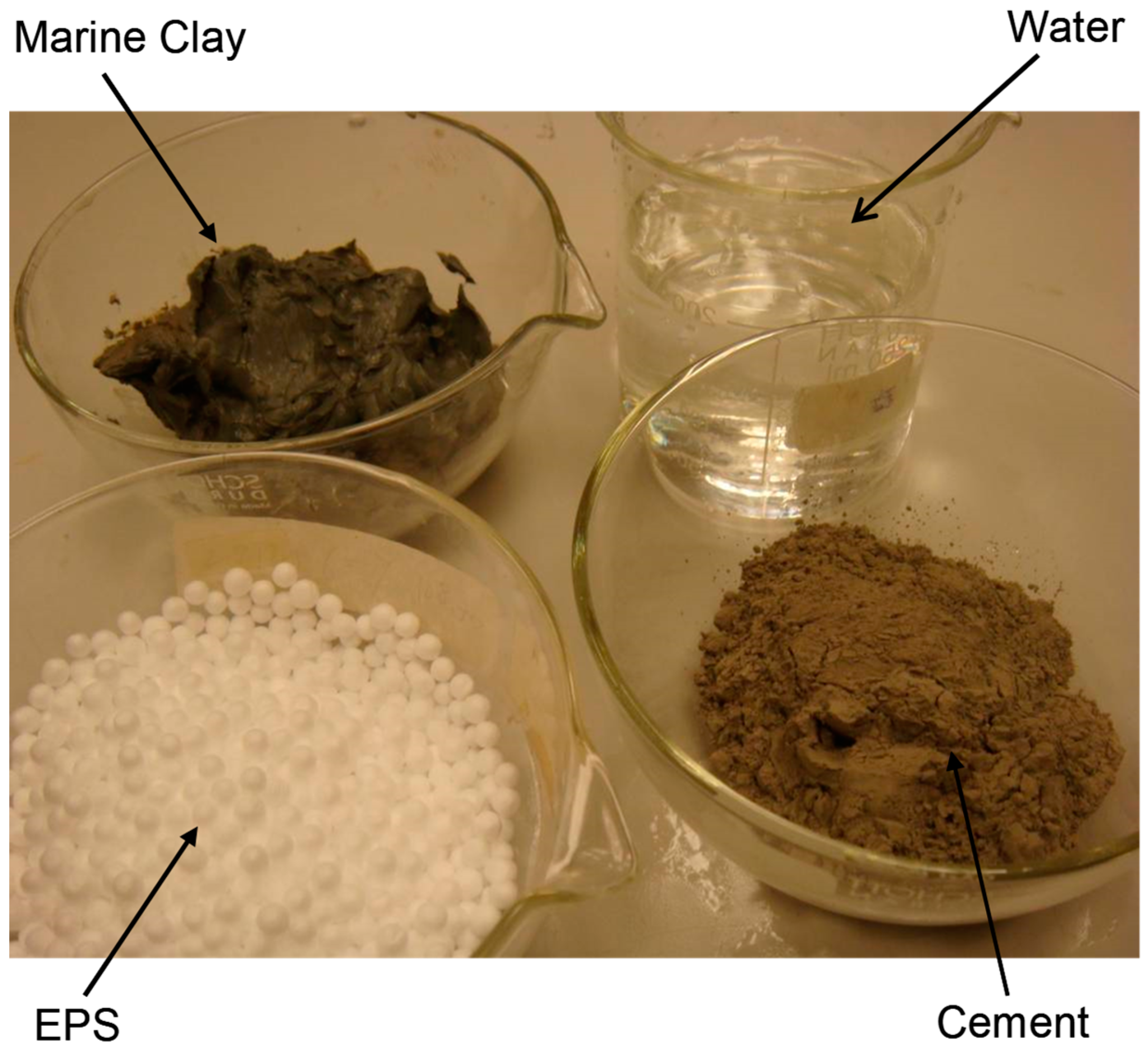
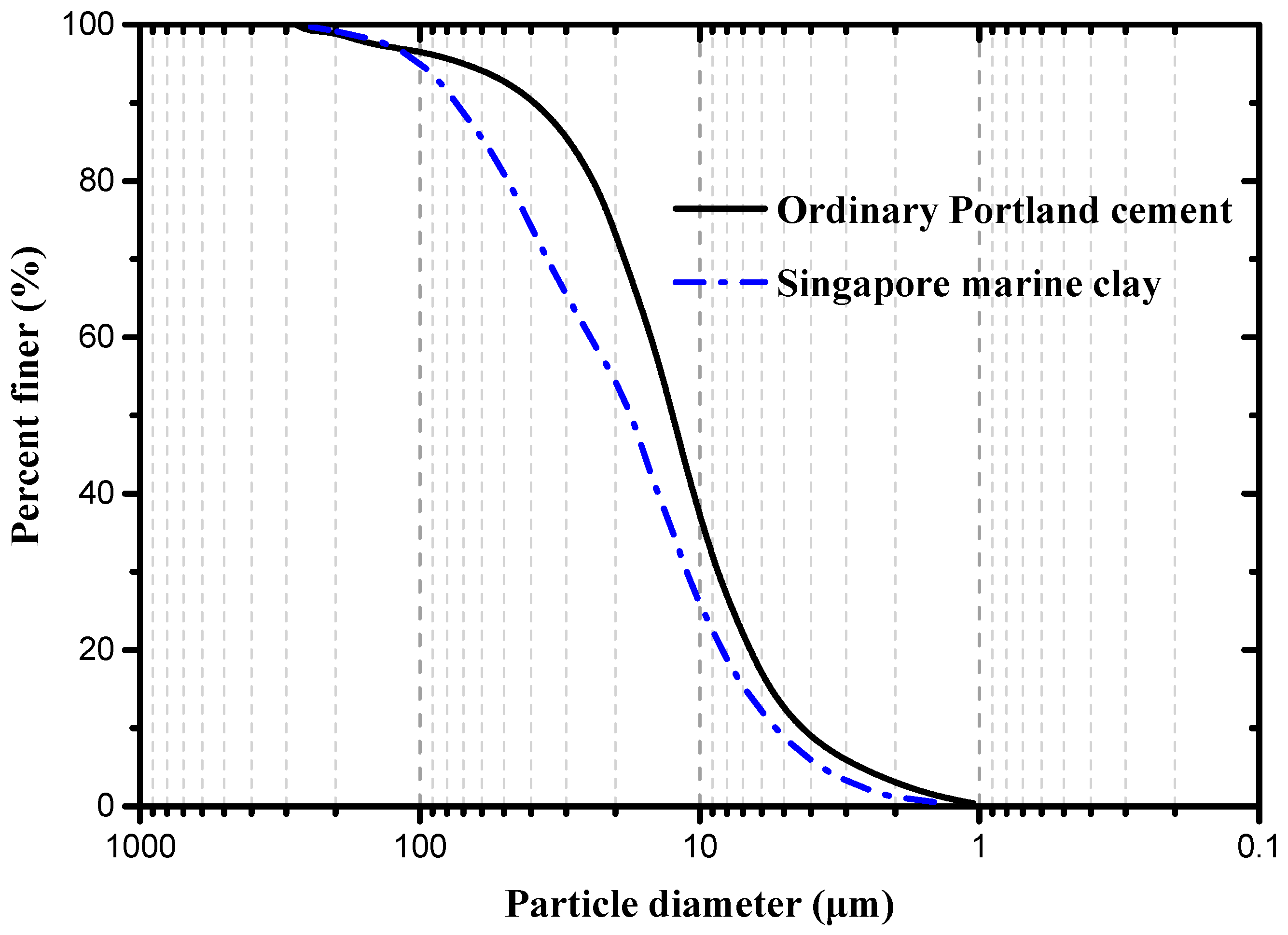
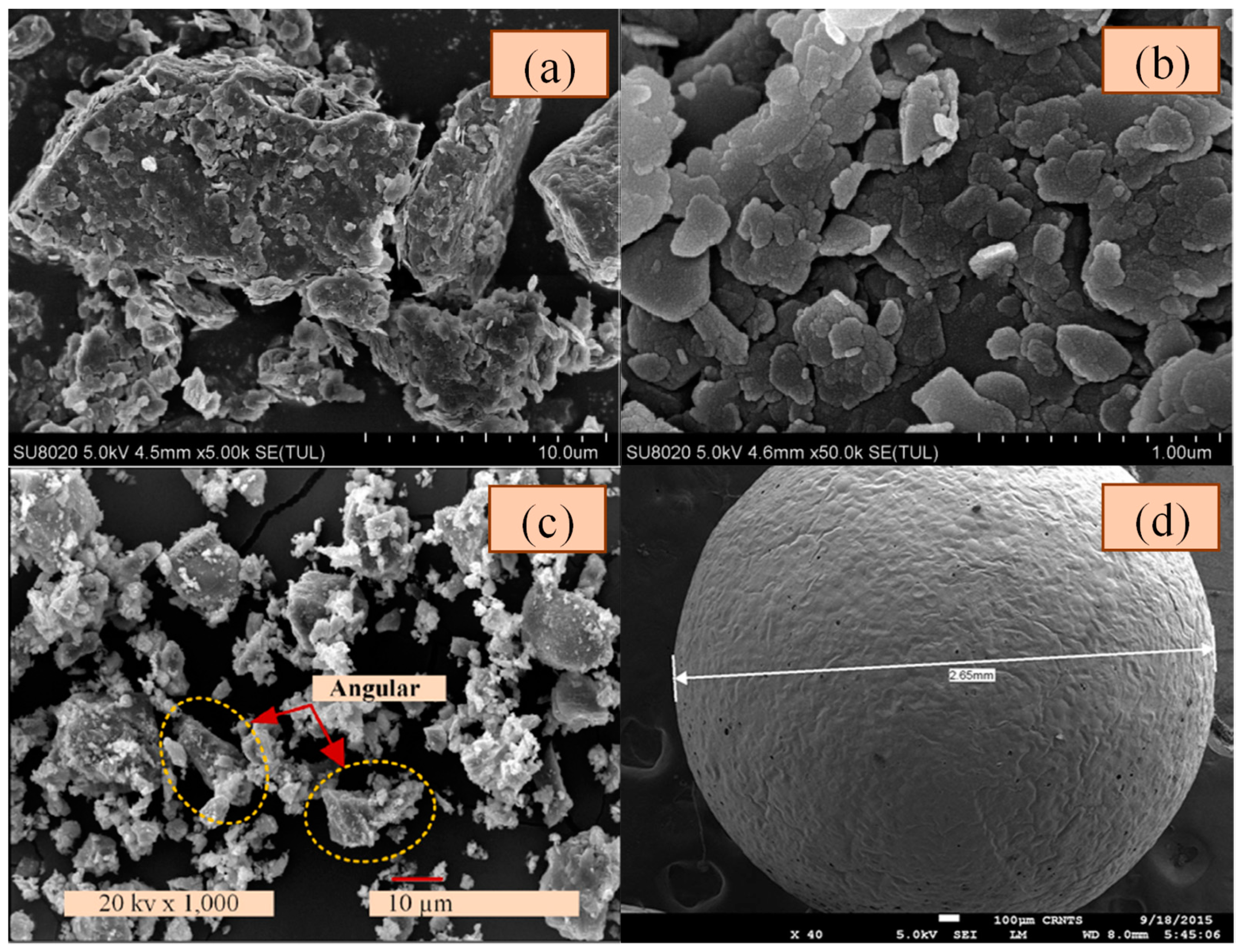
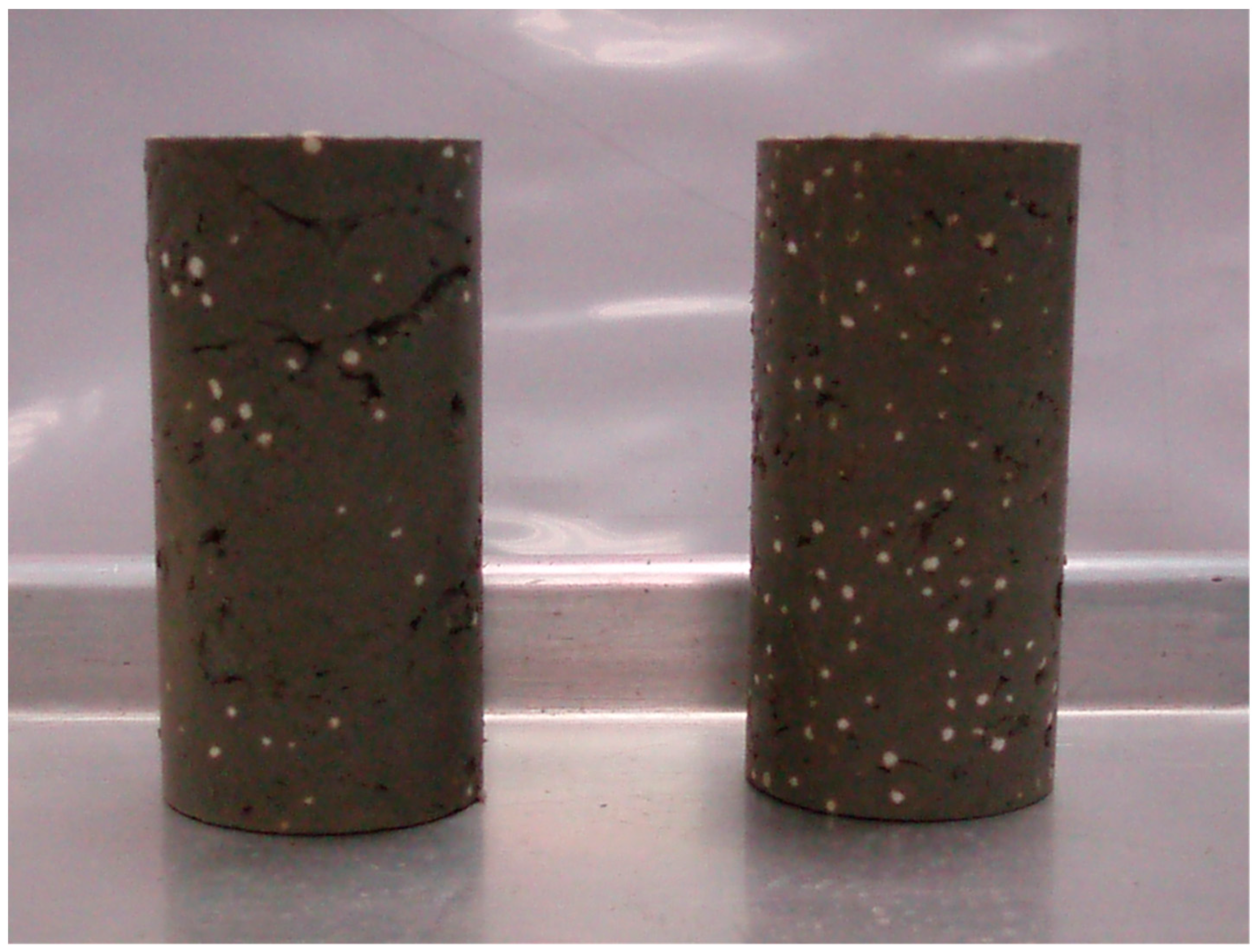
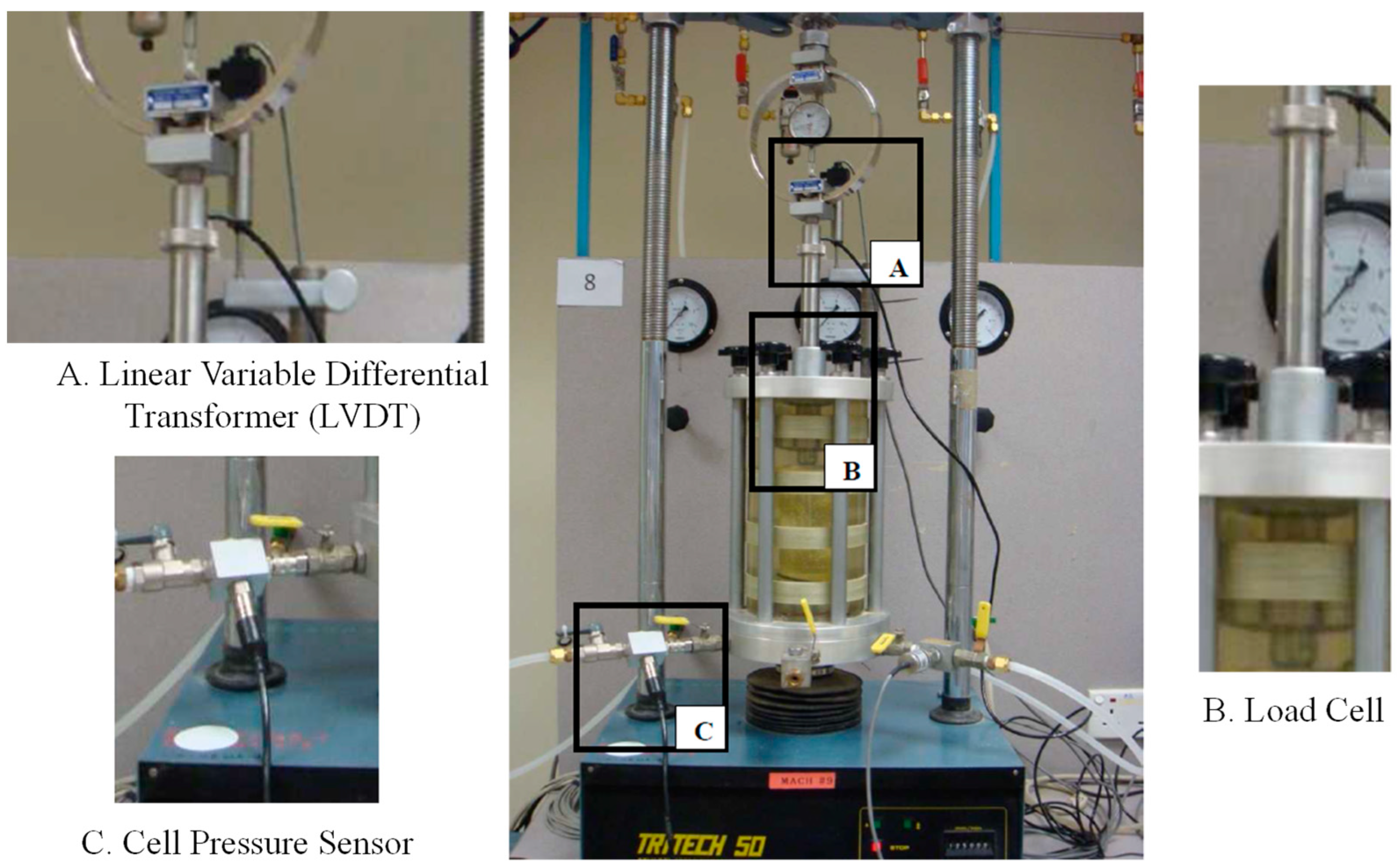

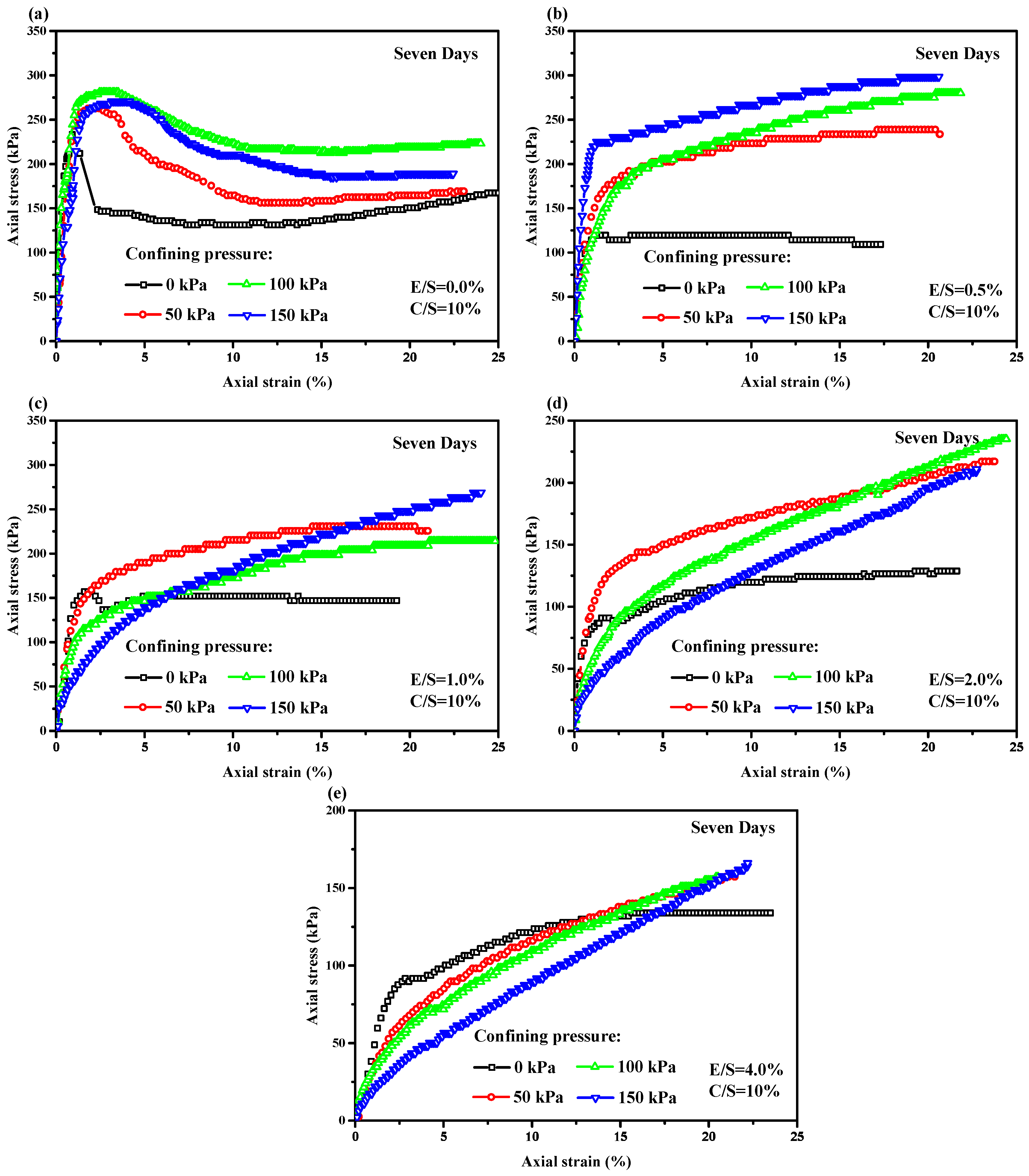
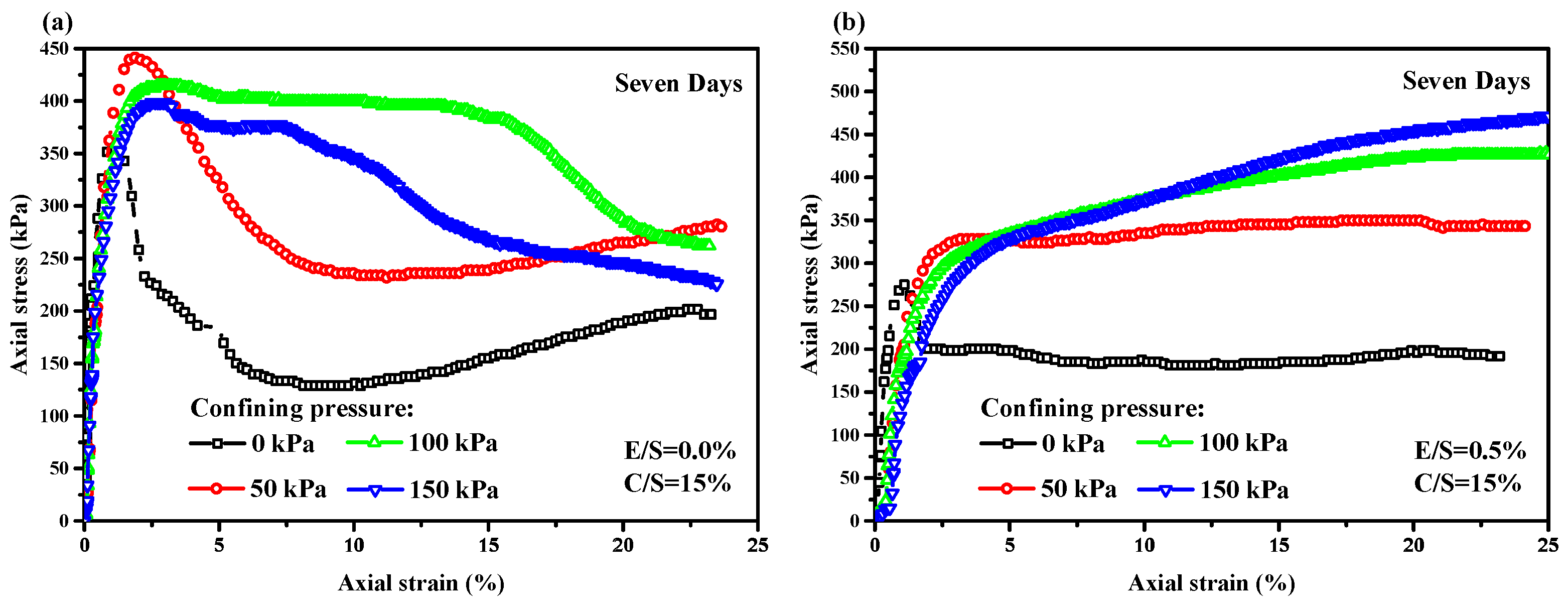
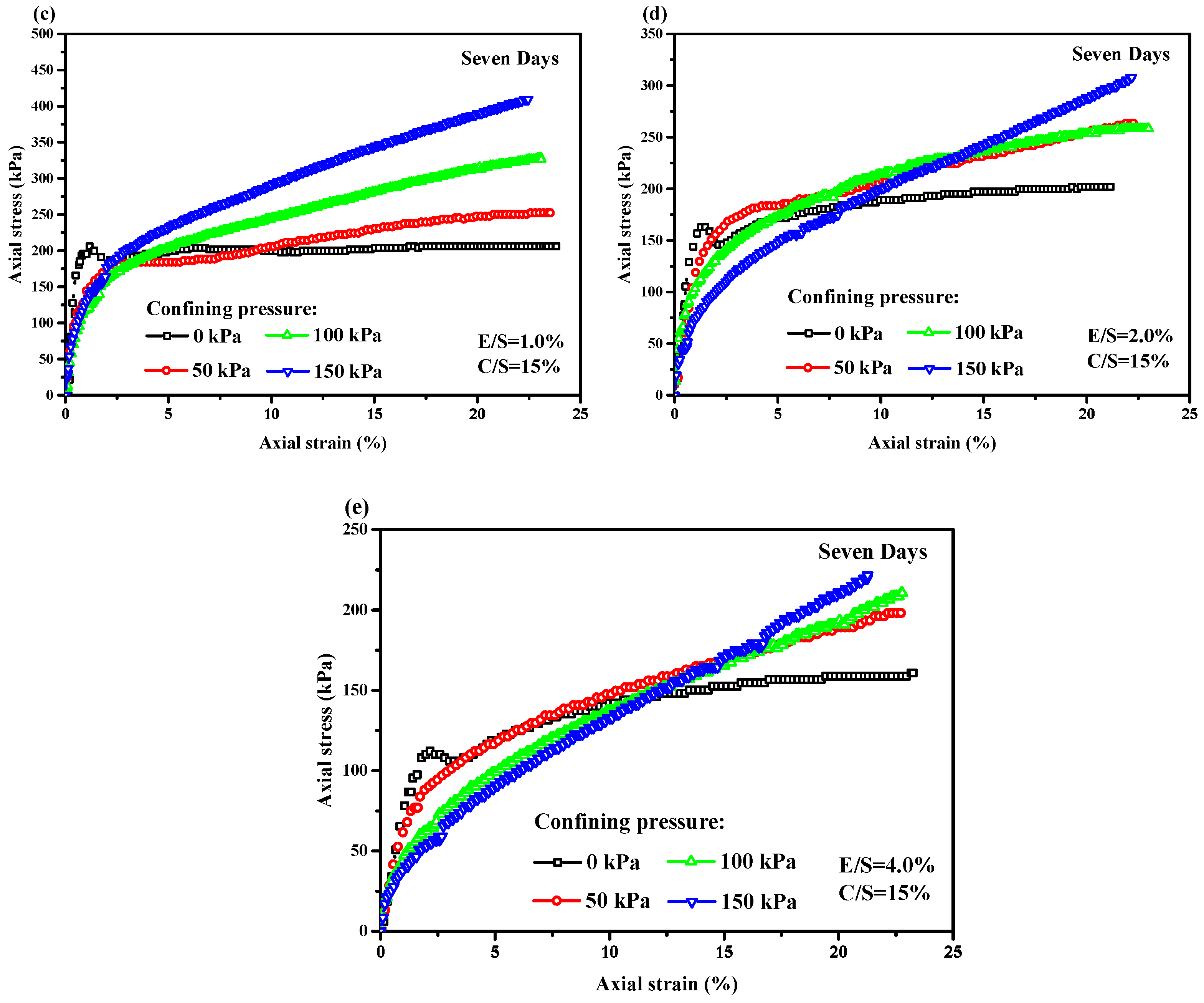
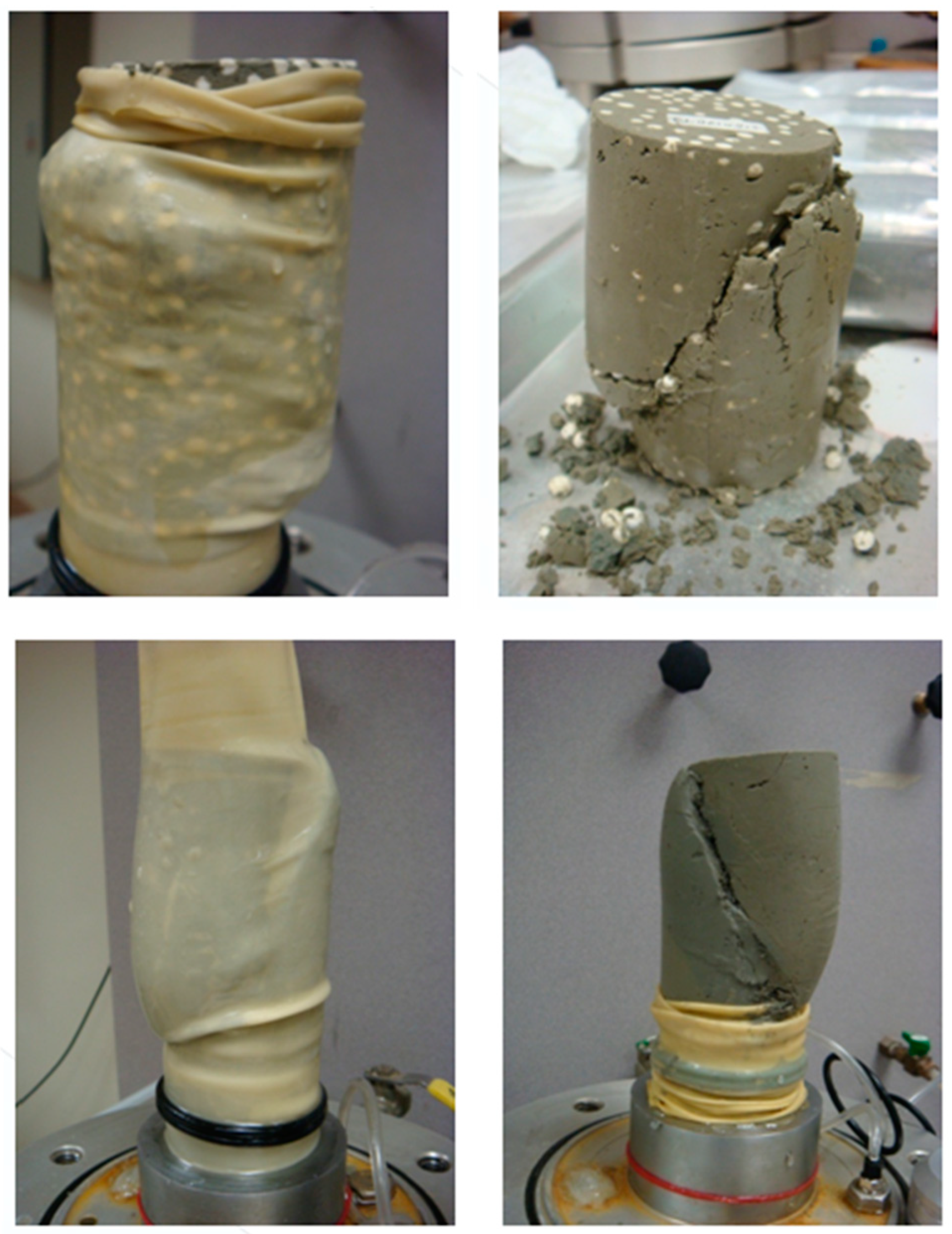
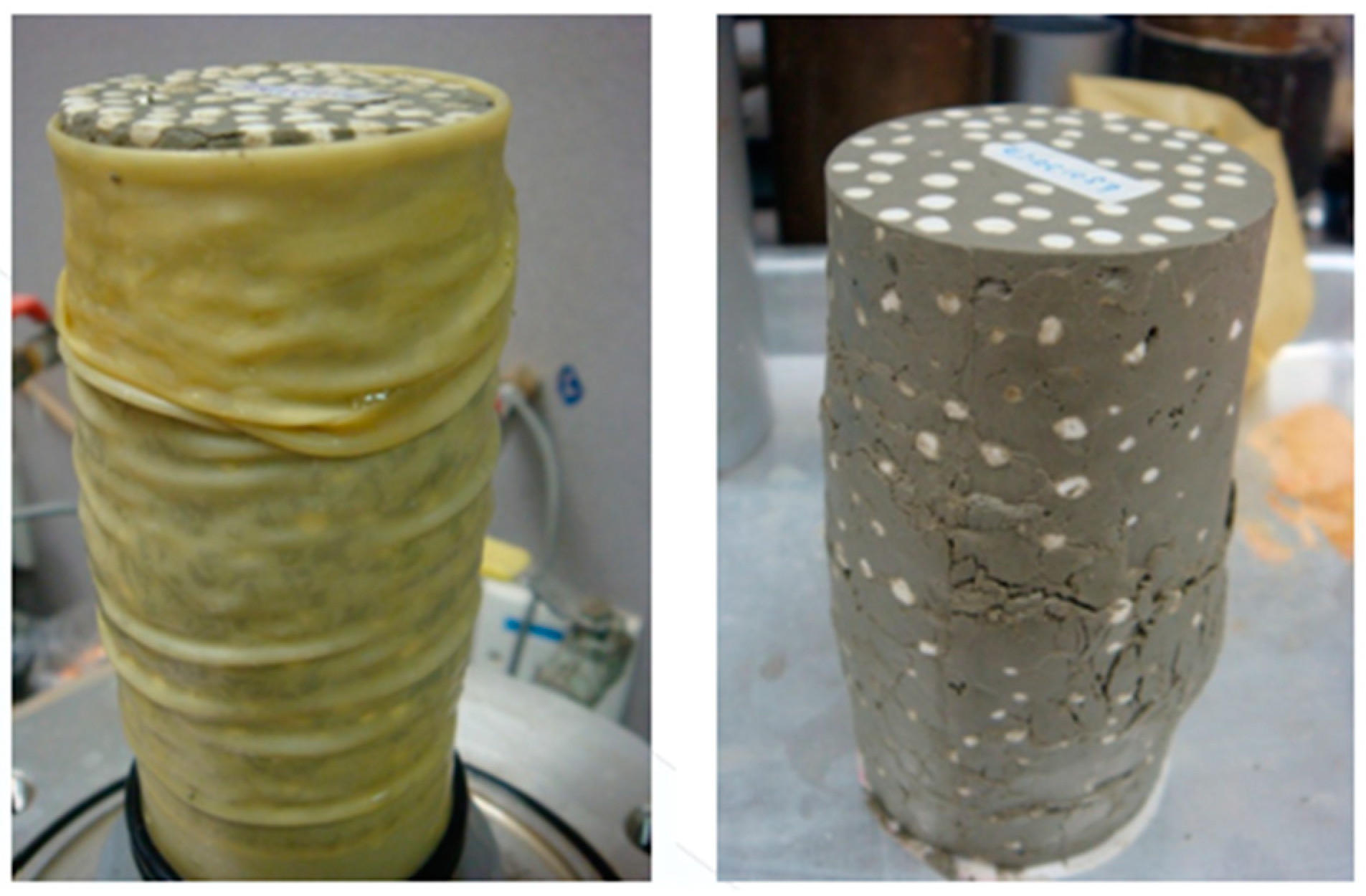
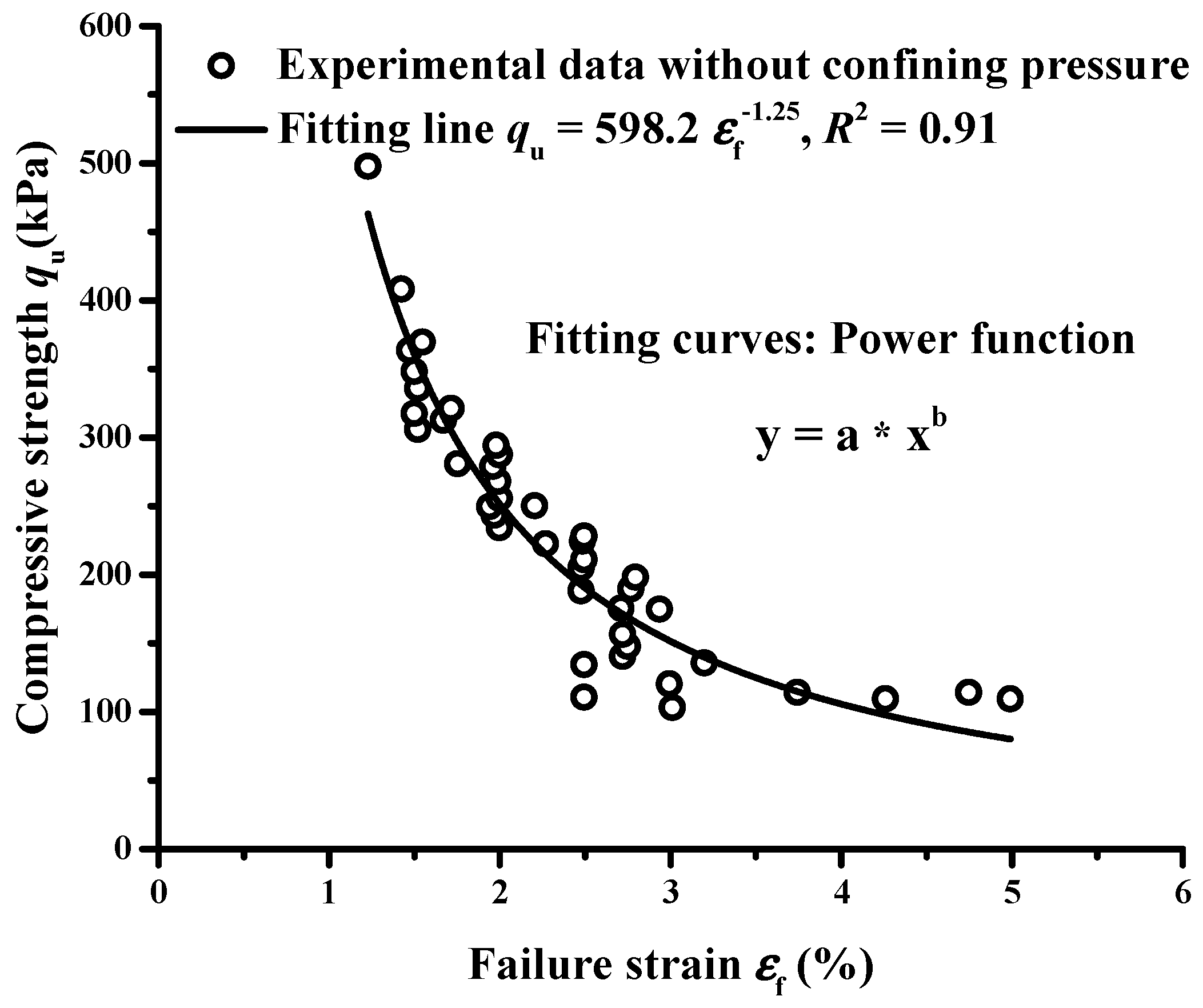
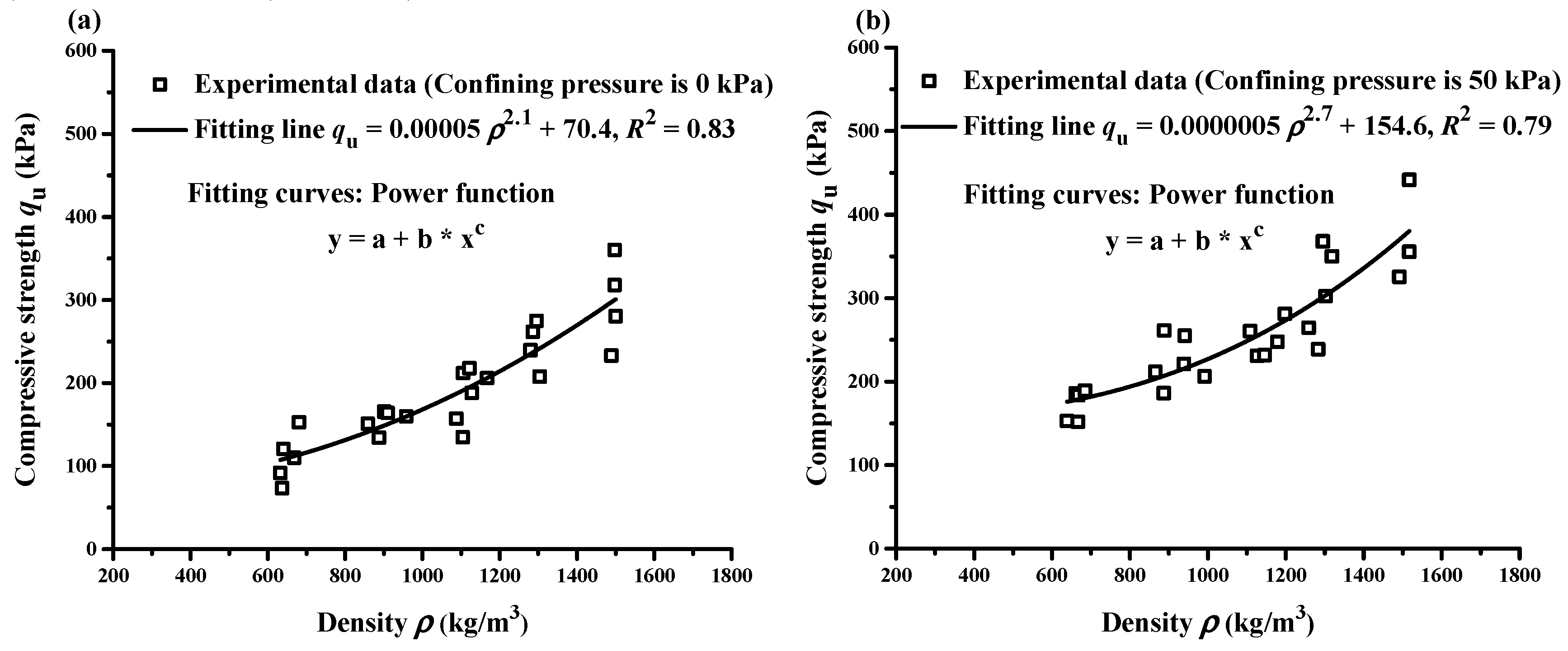


| Property | Value |
|---|---|
| Original water content (%) | 54.19 |
| Initial void ratio | 1.29 |
| Specific gravity | 2.65 |
| Bulk density (g/cm3) | 1.61 |
| Liquid limit (%) | 87.75 |
| Plasticity limit (%) | 40.04 |
| Plasticity index (%) | 47.71 |
| Shear strength (kPa) | 18.6–24.5 |
| Water to Clay, W/S (%) | Cement to Clay, C/S (%) | EPS to Clay, E/S (%) |
|---|---|---|
| 100 | 10 | 0.0, 0.5, 1.0, 2.0, 4.0 |
| 100 | 15 | 0.0, 0.5, 1.0, 2.0, 4.0 |
| Confining Pressure (kPa) | Fitting Equation | |
|---|---|---|
| 0 | 0.97 | |
| 50 | 0.83 | |
| 100 | 0.94 | |
| 150 | 0.95 |
© 2019 by the authors. Licensee MDPI, Basel, Switzerland. This article is an open access article distributed under the terms and conditions of the Creative Commons Attribution (CC BY) license (http://creativecommons.org/licenses/by/4.0/).
Share and Cite
Wang, J.; Hu, B.; Soon, J.H. Physical and Mechanical Properties of a Bulk Lightweight Concrete with Expanded Polystyrene (EPS) Beads and Soft Marine Clay. Materials 2019, 12, 1662. https://doi.org/10.3390/ma12101662
Wang J, Hu B, Soon JH. Physical and Mechanical Properties of a Bulk Lightweight Concrete with Expanded Polystyrene (EPS) Beads and Soft Marine Clay. Materials. 2019; 12(10):1662. https://doi.org/10.3390/ma12101662
Chicago/Turabian StyleWang, Jianguo, Bowen Hu, and Jia Hwei Soon. 2019. "Physical and Mechanical Properties of a Bulk Lightweight Concrete with Expanded Polystyrene (EPS) Beads and Soft Marine Clay" Materials 12, no. 10: 1662. https://doi.org/10.3390/ma12101662






